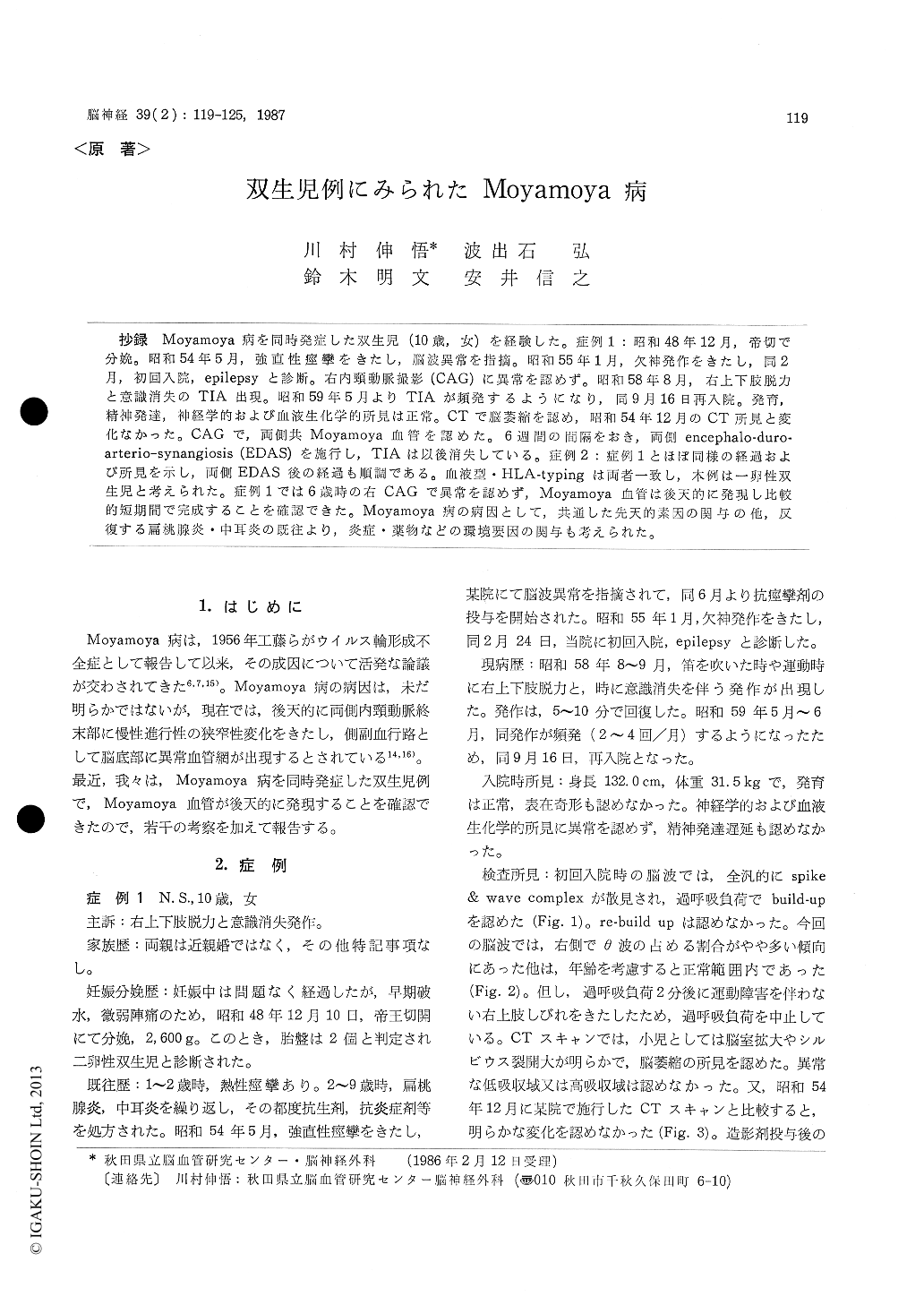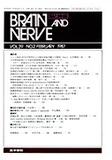Japanese
English
- 有料閲覧
- Abstract 文献概要
- 1ページ目 Look Inside
抄録 Moyamoya病を同時発症した双生児(10歳,女)を経験した。症例1:昭和48年12月,帝切で分娩。昭和54年5月,強直性痙攣をきたし,脳波異常を指摘。昭和55年1月,欠神発作をきたし,同2月,初回入院,epilepsyと診断。右内頸動脈撮影(CAG)に異常を認めず。昭和58年8月,右上下肢脱力と意識消失のTIA出現。昭和59年5月よりTIAが頻発するようになり,同9月16日再入院。発育,精神発達,神経学的および血液生化学的所見は正常。CTで脳萎縮を認め,昭和54年12月のCT所見と変化なかった。CAGで,両側共Moyamoya血管を認めた。6週間の間隔をおき,両側encephalo-duro-arterio-synangiosis (EDAS)を施行し,TIAは以後消失している。症例2:症例1とほぼ同様の経過および所見を示し,両側EDAS後の経過も順調である。血液型・HLA-typingは両者一致し,本例は一卵性双生児と考えられた。症例1では6歳時の右CAGで異常を認めず,Moyamoya血管は後天的に発現し比較的短期間で完成することを確認できた。Moyamoya病の病因として,共通した先天的素因の関与の他,反復する扁桃腺炎・中耳炎の既往より,炎症・薬物などの環境要因の関与も考えられた。
The authors described twins of ten-year-old girls who developed Moyamoya disease at the same time.
The family history showed no abnormality. They were born in 1973 under the cesarean sec-tion for the early rupture of the membranes and weak pains. The first case experienced tonic con-vulsions, and abnormal findings on the EEG were pointed out on May, 1979. Seven months later, CT scan was performed in another hospital, which showed the findings of brain atrophy. She ex-perienced absence attacks on January, 1980, and had the first adimission. She was diagnosed as epilep-sy. Right carotid angiography (CAG) was per-formed, which showed no abnormal findings. On August, 1983, she complained transient ischemic attacks (TIA) of right hemiweakness and some-times loss of consciousness for 5 to 10 minutes. She had the second admission on September, 1984. Growing status and neuro-psychological findings were normal. The EEG seemed almostly normal, but she complained a TIA on right upper txtre-mity two minutes after the hyperventilation, so the examination was stopped. CT findings was the same as that performed in 1979. Bilateral GAG showed marked stenosis of the internal caro-tid arteries (ICA) at the siphon and basal moya-moya vessels. Vertebral angiography had no steno-occlussive lesions. Left encephalo-duro-arterio-sy-nangiosis (EDAS) was performed, and six weeks later, right EDAS. Postoperatively, TIAs disap-peared and she had a good clinical course.
The second case had a similar history as de-scribed in case 1, except the abscence of epileptic attacks. EEG abnormality was pointed out, and she also had the diagnosis of epilepsy. She com-plained TIAs of weakness on the right upper extremity for 1 to 3 minutes. On admission, the mental functions were retarded mildly. The EEG showed sharp waves bilaterally. The findings of CT scan and 4-vessel angiography were similar to case 1. She also had a good clinical course after bilateral EDAS. As blood- and HLA-typing were identical in these twins, they were probably mo-novular twins.
The cause of moyamoya disease had not yet been clear. Moyamoya vessels were reported to be acquired forms as collaterals which would be resulted by the slowly progressive stenotic chan-ges in the bilateral ICA terminals. One of two cases in this report showed no abnormality on the right GAG at the age of 6, and the authors could prove that moyamoya vessels were ac-quired and completed within 4 years. As a cause of Moyamoya disease, the congenital factors could be suggested in these twins. The environmental fac-tors, including inflammations and drugs and so on, could be also suggested because these cases experienced tonsilitis and otitis media repeatedly from 2 to 9 years old.

Copyright © 1987, Igaku-Shoin Ltd. All rights reserved.


